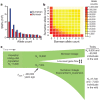Comparative and demographic analysis of orang-utan genomes
- PMID: 21270892
- PMCID: PMC3060778
- DOI: 10.1038/nature09687
Comparative and demographic analysis of orang-utan genomes
Erratum in
-
Author Correction: Comparative and demographic analysis of orang-utan genomes.Nature. 2022 Aug;608(7924):E36. doi: 10.1038/s41586-022-04799-7. Nature. 2022. PMID: 35962045 Free PMC article. No abstract available.
Abstract
'Orang-utan' is derived from a Malay term meaning 'man of the forest' and aptly describes the southeast Asian great apes native to Sumatra and Borneo. The orang-utan species, Pongo abelii (Sumatran) and Pongo pygmaeus (Bornean), are the most phylogenetically distant great apes from humans, thereby providing an informative perspective on hominid evolution. Here we present a Sumatran orang-utan draft genome assembly and short read sequence data from five Sumatran and five Bornean orang-utan genomes. Our analyses reveal that, compared to other primates, the orang-utan genome has many unique features. Structural evolution of the orang-utan genome has proceeded much more slowly than other great apes, evidenced by fewer rearrangements, less segmental duplication, a lower rate of gene family turnover and surprisingly quiescent Alu repeats, which have played a major role in restructuring other primate genomes. We also describe a primate polymorphic neocentromere, found in both Pongo species, emphasizing the gradual evolution of orang-utan genome structure. Orang-utans have extremely low energy usage for a eutherian mammal, far lower than their hominid relatives. Adding their genome to the repertoire of sequenced primates illuminates new signals of positive selection in several pathways including glycolipid metabolism. From the population perspective, both Pongo species are deeply diverse; however, Sumatran individuals possess greater diversity than their Bornean counterparts, and more species-specific variation. Our estimate of Bornean/Sumatran speciation time, 400,000 years ago, is more recent than most previous studies and underscores the complexity of the orang-utan speciation process. Despite a smaller modern census population size, the Sumatran effective population size (N(e)) expanded exponentially relative to the ancestral N(e) after the split, while Bornean N(e) declined over the same period. Overall, the resources and analyses presented here offer new opportunities in evolutionary genomics, insights into hominid biology, and an extensive database of variation for conservation efforts.
Conflict of interest statement
The authors declare no competing financial interests.
Figures





Comment in
-
Orangutan genome mix-up muddies conservation efforts.Nature. 2022 Oct;610(7933):617-618. doi: 10.1038/d41586-022-03193-7. Nature. 2022. PMID: 36261725 No abstract available.
References
-
- Singleton, I. et al. Orangutan Population and Habitat Viability Assessment: Final Report (IUCN/SSC Conservation Breeding Specialist Group, Apple Valley, 2004)
Publication types
MeSH terms
Substances
Grants and funding
LinkOut - more resources
Full Text Sources
Other Literature Sources
Molecular Biology Databases

